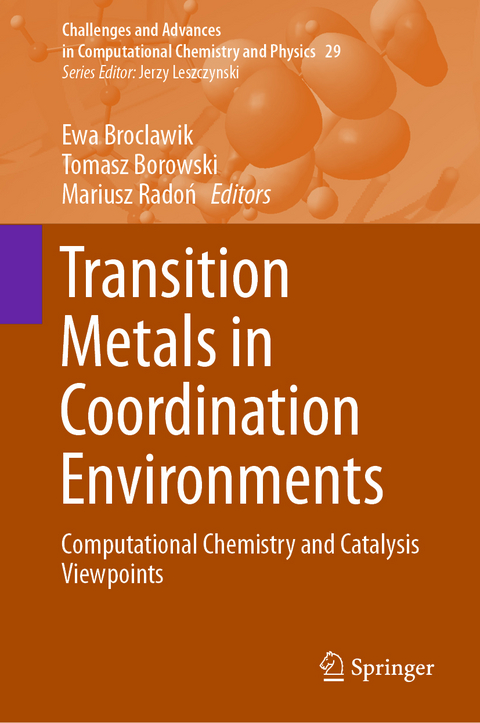
Transition Metals in Coordination Environments
Springer International Publishing (Verlag)
978-3-030-11713-9 (ISBN)
Ewa Broclawik is a Professor Emeritus and former Full Professor at the Jerzy Haber Institute of Catalysis and Surface Chemistry, Polish Academy of Sciences in Krakow, Poland. Her research interests focus on theoretical and applied quantum chemistry, in particular on the modeling of active sites in heterogeneous and enzymatic catalysis and on catalytic reaction mechanisms. Dr. Broclawik is the author of more than 180 publications, including 9 book chapters. Tomasz Borowski is a Full Professor at the Jerzy Haber Institute of Catalysis and Surface Chemistry, Polish Academy of Sciences. His research interests encompass computational chemistry, biochemistry, reaction mechanisms, metalloenzymes, and protein structure and dynamics. Dr. Borowski has published more than 60 research papers in refereed journals as well as 3 book chapters. Mariusz Radon is an Assistant Professor at Jagiellonian University, Krakow, Poland. His primary research interest is in quantum chemistry, especially its applications to transition metal complexes and active sites of metalloproteins, with a focus on electronic structure, spin-state energetics, metal-ligand interactions and connections to catalytic activity. Dr. Radon is the author of 30 publications, including 1 book chapter.
From the content: Review of the current status of knowledge in the field of recent achievements in computational modeling and their interplay with experiment.- Density matrix renormalization group (DMRG): An emerging method in bioinorganic chemistry.- Approaching magnetic interactions in oligonuclear transition metal clusters with density matrix renormalization group.- New strategies in modelling electronic structures and properties in actinides.- X-ray probes of electronic structure in transition metal complexes.- Electronic spectroscopy of cobalamins studied with density functional theory.- Spin magnetic properties of transition metal complexes.- Computational studies of transition-metal catalysis in biological and non-biological settings.- The role of non-covalent interactions in metal complexes.- Molecular electrochemistry of coordination compounds - a correlation between quantum-chemical calculations and experiment.- Computational modelling of structure and catalytic properties of supported group VI transition metal oxide species.- Catalytic properties of TM in inorganic coordination environments.- Challenges in modeling metalloenzymes and their troubleshooting.- The quest for accurate theoretical models of metalloenzymes: an aid to experiment.- Metal coordination in the active sites of selected metalloenzymes: a theoretical point of view.- Metal - redox-active ligand cooperation in biomimetic transition metal compounds to exhibit metal-centered multi-electron reactivity.- Computational vs. experimental spectroscopy for transition-metals.- The electronic determinants of spin crossover described by density functional theory.- Photodeactivation channels of transition metal complexes: a computational chemistry perspective.
| Erscheinungsdatum | 30.03.2019 |
|---|---|
| Reihe/Serie | Challenges and Advances in Computational Chemistry and Physics |
| Zusatzinfo | XV, 532 p. 209 illus., 171 illus. in color. |
| Verlagsort | Cham |
| Sprache | englisch |
| Maße | 155 x 235 mm |
| Gewicht | 979 g |
| Themenwelt | Naturwissenschaften ► Chemie ► Physikalische Chemie |
| Schlagworte | actinides • Biomimetic Complexes • Density functional theory transition metals • Electrochemistry of coordination compounds • Metalloenzymes • Reaction mechanisms • Transition Metal Catalysis • Transition Metal Catalysts • Transition metal clusters • transition metals • Transition metals complexes • Transition metals computational chemistry • Transition metals coordination environments • Transition metals DFT • Transition metals quantum chemistry • Transition metals spectroscopy |
| ISBN-10 | 3-030-11713-8 / 3030117138 |
| ISBN-13 | 978-3-030-11713-9 / 9783030117139 |
| Zustand | Neuware |
| Haben Sie eine Frage zum Produkt? |
aus dem Bereich


